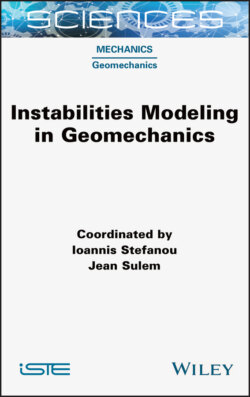Читать книгу Instabilities Modeling in Geomechanics - Jean Sulem - Страница 9
Оглавление
Introduction
Ioannis STEFANOU1 and Jean SULEM2
1GeM, Ecole Centrale de Nantes, France
2Navier, Ecole des Ponts ParisTech, Université Paris-Est, Marne-la-Vallée, France
Nuclear waste disposal, petroleum engineering, CO2 sequestration, geothermal energy, tunneling, slope stability, geotechnics, borehole stability, drying cracking and earthquake nucleation are important applications of geomechanics with short- and long-term environmental and societal impacts. Geomechanical systems involve various multiphysical and non-linear processes at several length and time scales. These complex mechanisms are described by non-linear differential equations that express the evolution of the various state variables of a system (e.g. displacements, temperature, pore pressure etc.). In order to study the evolution of the system and the possible occurrence of instabilities, it is necessary to explore the mathematical properties of the governing equations. Therefore, questions about the existence, uniqueness and stability of solutions arise naturally. Bifurcation theory and stability analysis are robust and rigorous tools for qualitatively and quantitatively investigating various instabilities such as strain localization, thermal runaway and unstable pressure increase, without explicitly determining the solutions of the governing non-linear equations of a geomechanical system.
The purpose of this book is to present the basic ideas of bifurcation theory and its application to classical problems of geomechanics. The book is organized into nine chapters.
The first chapter, “Multiphysics Role in Instabilities in Geomaterials: A Review”, provides in situ and laboratory evidence of instabilities in geomechanical applications, mostly induced by multiphysical phenomena at various scales, such as heat generated during pre-cursor creep in the development of landslides, geochemical reactions, the effect of heat on inducing possible failure through pressurization of pore water, the effect of evaporation-induced suction and air entry during drying and subsequent cracking of soils.
The second chapter, “Fundamentals of Bifurcation Theory and Stability Analysis”, aims to provide the basic ideas of bifurcation theory and stability analysis. It focuses on giving the necessary vocabulary for the classification of common bifurcations that are often met in applications and, finally, it presents the application of the theory for studying strain localization in solids. Some aspects related to shear band thickness, mesh dependency and higher order continua are also briefly discussed.
The third chapter, “Material Instability and Strain Localization Analysis”, covers the principles of strain localization analysis as applied to geomaterials. The conditions for the formation of different types of deformation bands are given and an extension of the analysis to fluid-saturated porous media is presented.
The fourth chapter, “Experimental Investigation of the Emergence of Strain Localization in Geomaterials”, focuses on strain field measurements of strain localization. Full field methods, imaging tools and experimental loading apparatus have evolved considerably over the past 15 years. This chapter presents recent developments on the characterization of the strain localization process and introduces the methods that are most frequently used.
The fifth chapter, “Numerical Modeling of Strain Localization”, gives the basic concepts of numerical modeling of the post-localization regime of strain softening geomaterials. For this purpose, two higher-order continua with microstructure are presented. This type of continuum is used to regularize the ill-posed mathematical problem of strain-softening materials and to enable the modeling of progressive localization of deformation in zones of intense shearing that eventually leads to failure.
The sixth chapter, “Numerical Modeling of Bifurcation: Applications to Borehole Stability, Multilayer Buckling and Rock Bursting”, presents typical boundary value problems of bifurcation theory in applications related to the petroleum industry, mining and structural geology. The formulation of the bifurcation problem is described and the governing equations are integrated numerically using higher-order continua with microstructure, such as the Cosserat continuum.
The seventh chapter, “Numerical Modeling of Multiphysics Couplings and Strain Localization”, focuses on the numerical modeling of localized phenomena induced by multiphysical couplings. To deal with interactions that occur between the different phases of porous media, a regularization technique based on the second gradient model is used.
The next two chapters, “Multiphysics Couplings and Strain Localization in Geomaterials” and “On the Thermo-poro-mechanics of Chemically Active Faults”, provide a review of research regarding the effects of temperature, pore pressure, chemical reactions and microstructure on strain localization in geomaterials. Examples have been given in relation to seismic slip in outcrops, core drillings on active faults and compaction banding.
The last chapter, “Theoretical and Numerical Analysis of Softening and Instabilities in Faults”, focuses on the Cosserat continuum, strain-localization and thermo-hydro-mechanical couplings. The interplay of different length and time scales is shown and the role of the size of the microstructure is emphasized.
We would like to thank all of the contributors of this volume and we hope that the chapters provide a valuable introduction to bifurcation theory and stability in geomechanics, covering the state of the art of theoretical, experimental and numerical developments in the field.
This volume is dedicated to the memory of late Professor Ioannis Vardoulakis (1949–2009) on the 10th anniversary of his death, in recognition of his contributions and achievements in mechanics, geomechanics and bifurcation theory.
